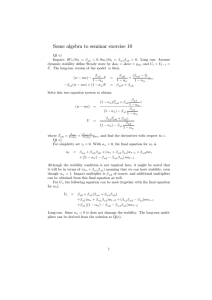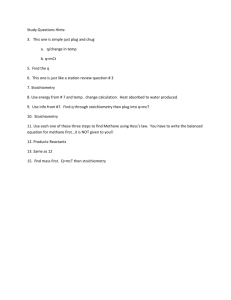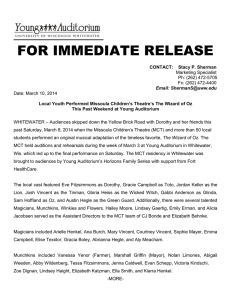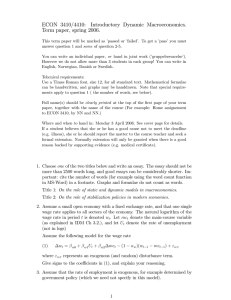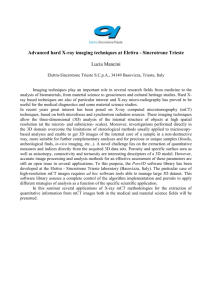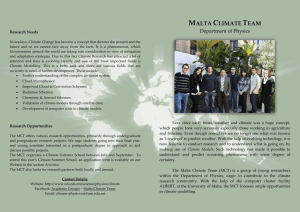197 X SIMPOZIJUM Energetska elektronika 10 SYMPOSIUM on
advertisement
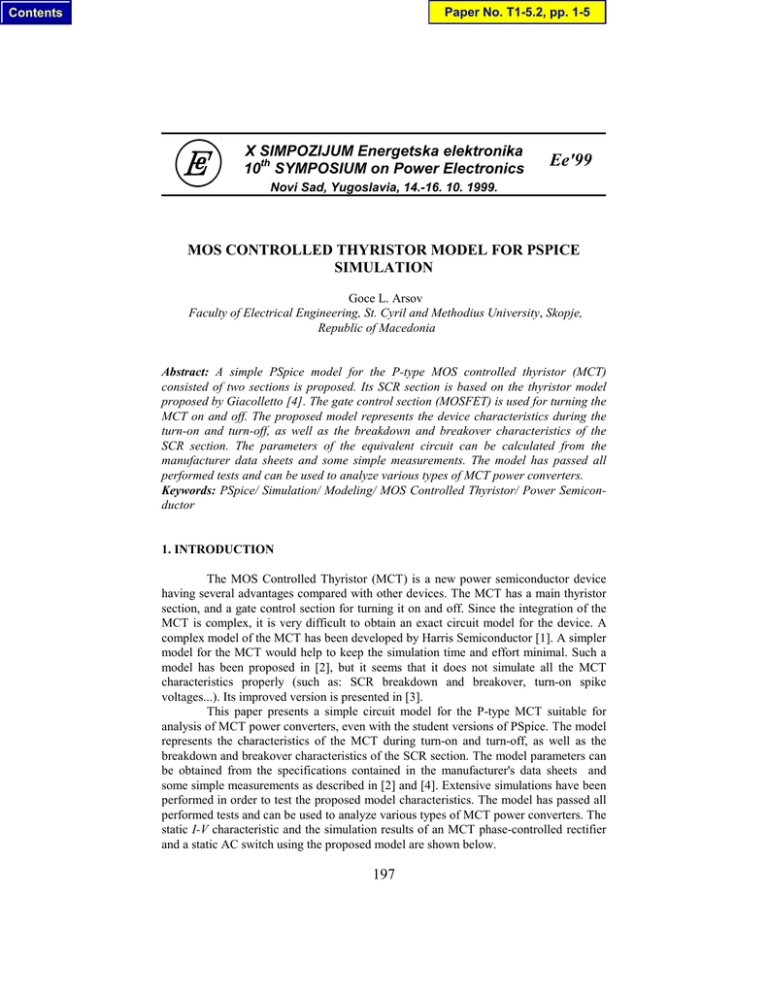
Paper No. T1-5.2, pp. 1-5
Contents
X SIMPOZIJUM Energetska elektronika
10th SYMPOSIUM on Power Electronics
Ee'99
Novi Sad, Yugoslavia, 14.-16. 10. 1999.
MOS CONTROLLED THYRISTOR MODEL FOR PSPICE
SIMULATION
Goce L. Arsov
Faculty of Electrical Engineering, St. Cyril and Methodius University, Skopje,
Republic of Macedonia
Abstract: A simple PSpice model for the P-type MOS controlled thyristor (MCT)
consisted of two sections is proposed. Its SCR section is based on the thyristor model
proposed by Giacolletto [4]. The gate control section (MOSFET) is used for turning the
MCT on and off. The proposed model represents the device characteristics during the
turn-on and turn-off, as well as the breakdown and breakover characteristics of the
SCR section. The parameters of the equivalent circuit can be calculated from the
manufacturer data sheets and some simple measurements. The model has passed all
performed tests and can be used to analyze various types of MCT power converters.
Keywords: PSpice/ Simulation/ Modeling/ MOS Controlled Thyristor/ Power Semiconductor
1. INTRODUCTION
The MOS Controlled Thyristor (MCT) is a new power semiconductor device
having several advantages compared with other devices. The MCT has a main thyristor
section, and a gate control section for turning it on and off. Since the integration of the
MCT is complex, it is very difficult to obtain an exact circuit model for the device. A
complex model of the MCT has been developed by Harris Semiconductor [1]. A simpler
model for the MCT would help to keep the simulation time and effort minimal. Such a
model has been proposed in [2], but it seems that it does not simulate all the MCT
characteristics properly (such as: SCR breakdown and breakover, turn-on spike
voltages...). Its improved version is presented in [3].
This paper presents a simple circuit model for the P-type MCT suitable for
analysis of MCT power converters, even with the student versions of PSpice. The model
represents the characteristics of the MCT during turn-on and turn-off, as well as the
breakdown and breakover characteristics of the SCR section. The model parameters can
be obtained from the specifications contained in the manufacturer's data sheets and
some simple measurements as described in [2] and [4]. Extensive simulations have been
performed in order to test the proposed model characteristics. The model has passed all
performed tests and can be used to analyze various types of MCT power converters. The
static I-V characteristic and the simulation results of an MCT phase-controlled rectifier
and a static AC switch using the proposed model are shown below.
197
2. CIRCUIT MODEL FOR THE P-TYPE MCT
The PSpice model for the P-type MCT is derived from the transistor level
equivalent of MCT shown in Fig. 1. Its SCR section is developed by expanding the
thyristor model presented in [4]. The gate control section consisting of a PMOS and an
NMOS is modeled using simple RC circuit for the controlling of the turn-on and turn-off
times and with simple diodes (DPMOS and DNMOS) to isolate the operation of the
MOSFET's in such a manner that the triggering pulse of one polarity activates only one
process of the MCT (either turn-on or turn-off).
CATHODE (OUTPUT)
Q1
NPN
NMOS
Q2
PNP
PMOS
GATE
(INPUT)
ANODE (COMMON)
Fig. 1. Transistor level equivalent circuit of the MCT
The complete PSpice model is shown in Fig. 2 and the complete list of the
PSpice statements for the subcircuit description of the proposed MCT model is
presented in the appendix. The parameters of the MOSFET section can be calculated
according the method presented in [2], and the parameters for the SCR section
according the procedure explained in [4].
10
A
32
RSCR
RGN
DNMOS
G
11
33
30
DPMOS
RGP
CMOS
SSCR
9
31
CBR
DBR
D1
4
+
VAS
-
+
VGS
5
EGS
-
20
20
RSENCE
DSENCE
+
RGS
25
D1
6
K
Fig. 2. PSpice model of the MCT
198
CR
FSENCE
When a negative pulse is applied to the gate of the PMOS, the capacitor CMOS
charges up. The voltage across CMOS increases the current through VGS and consequently
the value of FSENCE which charges the capacitor CR. The switch will be closed and the
MCT in the ON state. Once the MCT is turned on, the current through VAS will keep the
device in the on state.
Once a positive pulse is applied to the gate, the capacitor CMOS charges in the
opposite direction, the EGS reverses its direction and so does the current from FSENCE
The voltage across CR changes its direction. The switch will turn off. The MCT is in the
off state. The behaviour of the SCR section of the model is explained in [4]. The diode
DBR is included to ensure the breakover and breakdown capabilities of the MCT model,
while the capacitor CBR is added to provide the proper dv/dt characteristics.
3. SIMULATION RESULTS
Extensive simulations have been performed in order to test the proposed model
characteristics. The model has passed all performed tests and can be used to analyze
various types of MCT power converters. The static I-V characteristic of the MCT model
given in Fig. 2, with the parameters defined by the statements in the appendix, is given
in Fig. 3. The breakover and breakdown characteristics are clearly displayed.
100A
I
-100A
-0.2KV
0V
0.2KV
0.4KV
V
0.6KV
0.8KV
1.0KV
AK
Fig. 3. Static I-V characteristic of the PSpice model for the MCT given in Fig. 2
The simulation results for the complete circuit of an MCT phase-controlled
rectifier, shown in Fig. 4, are presented in Fig. 5. The converter uses a diode bridge to
rectify the input ac voltage. The MCT is used as a phase-controlled switch to control the
flow of power from the ac source. The diode Dm provides the freewheeling action. The
waveforms of the input voltage, load voltage and gate pulses are shown in Fig. 5.
Comparing them with the experimental waveforms shown in [2] it can be seen that the
simulated waveforms agree very well with the experimental ones.
Pspice model
A-C input
Dm
Gate
R-L
Load
Fig. 4. Power circuit of the MCT phase-controlled rectifier
199
200V
-200V
200V
0V
20V
-20V
Vin
Vload
20ms
Vgate
25ms
30ms
Time
35ms
40ms
45ms
50ms
Fig. 5. Simulated MCT converter waveforms
The successful simulation results have been obtained for other circuits. Some
tests described in [1] have been successfully passed. For example, in Fig. 7 we present
the simulation results for an AC switch using two MCTs with common gate circuit (Fig.
6). It can be seen that they correspond very well with the experimental waveforms given
in [1] (Fig. 6.4.2). The comparative simulations have been performed using the P-type
MCT models developed in [2] and [3], and the MCT model developed by Harris
Semiconductor (MCTV75P60E1), available on Internet. The simulation times were
shorter, in average, by 15%, comparing with those obtained with the model from [3],
and by 33 % than those obtained using the HARRIS Semiconductor model. All
simulations have been performed using the PSpice Evaluation version 5.0a.
D2
D1
R1
MCT1
MCT2
Gating Circuit
Fig. 6. AC switch using two MCTs with common gate circuit
200V
200V
-200V
20V
-20V
100A
-100A
0s
-200V
v(2,21)
20V
-20V
v(5,4)
i(rin)
40A
10ms
20ms
30ms
40ms
-40A
0s
50ms
Time
v(2,21)
v(5,4)
i(rin)
10ms
20ms
30ms
40ms
50ms
Time
(a)
(b)
Fig. 7. Simulation waveforms or the AC switch of Fig. 6: upper trace − input voltage;
middle trace − gate control voltage; lower trace − load (5 Ohms, 20 µF) current.
(a) Closing at zero, opening near mid-cycle; (b) closing at mid-cycle, opening near zero
200
4. CONCLUSION
The paper presents a simple PSpice model of the MCT. The model has a
thyristor section and one section, combining two MOSFET's, for turning the MCT on
and off. The model is simple and it represents the characteristics of the MCT during
turn-on and turn-off, as well as the breakdown and breakover characteristics of the SCR
section. The extensive simulations performed show very good behaviour of the proposed
model. The simulation results are compared with those presented in [2] and [3], and also
with the results obtained using the MCT model developed by Harris Semiconductor and
available on Internet. The proposed model needs less memory requirements, and the
simulation times were shorter by 15% to 33% comparing with the other available
models.
5. REFERENCES
[1] MCT User`s Guide, Harris Semiconductor Corporation, 1995
[2] S.Yuvarajan and D.Quek, "A PSPICE Model for the MOS Controlled Thyristor"
IEEE Trans. Ind. Electron, Vol. 42, No 5, pp 554-558, 1995.
[3] G.L.Arsov and Ljupco P.Panovski, "An Improved PSpice Model for the MOS
Controlled Thyristor", IEEE Trans. Ind. Electron., Vol. 43, No. 2, pp 473-477, 1999
[4] L.J.Giacoletto, "Simple SCR and TRIAC Computer Models, IEEE Trans. Ind.
Electron, Vol. 36, No 3, pp 451-455, 1989.
APPENDIX
Subcircuit description of the MCT
.MODEL D
D(N=.1)
VAS
4 20 0
.MODEL SSCR
VSWITCH(RON=.0125
+ ROFF=103000 VON=1 VOFF=0)
FSENSE 20
6 POLY(2) VGS
+ VAS -.05 55 11
DSENCE 20
6 DS
.MODEL DS D(RS=.05)
RSENSE 6 20
1
CR
6 20 5U
CBREAK 11
4 18P
DBREAK 4 11 DBR
.MODEL DBR D(BV=900 N=6
+ IS=1E-14)
.ENDS
*MCT model
.SUBCKT MCT 10 20 30
*--------------------A K G
RGP
30 31 5
RGN
30 32 8.33
CMOS
33 10 18.92N
DPMOS 33
31 D
DNMOS 32
33 D
*SCR SECTION
EGS
25 20 TABLE {V(33,10)}
+ (-100,-100) (-.15,0) (.15,0) (100,800)
RGS
25
5 1
VGS
20
5 0
RSCR 10 11 .005
SSCR 11
9 6 20 SSCR
D1
9
4 D
D:\jaca\ Ee_homeSivi.gif (58x22x256 gif)
201
